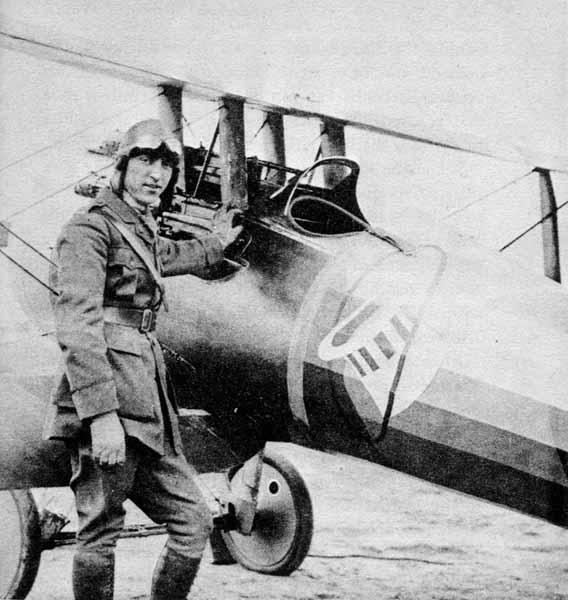
Edward Vernon "Eddie" Rickenbacker (* October 8, 1890 in Columbus, Ohio; † July 23, 1973 in Zurich, Switzerland) was a U.S. automobile racer, entrepreneur, and World War I fighter pilot. With 26 aerial victories, he was the most successful fighter pilot of the United States in World War I.
Life before fighter pilot:
Edward Rickenbacher (no middle name) was born the third of eight children in a Swiss immigrant family from Zeglingen in the Baselbiet region. His parents were Wilhelm (1857-1902) and Elisabeth, a native of French-speaking Switzerland. They emigrated to Ohio in 1880. During World War I and anti-German sentiment, he decided to change his last name to "Rickenbacker" and he adopted the middle name "Vernon."
In 1902, after Eddie's father William suffered a fractured skull on a construction site due to quarrels and died a month later, the boy left school to support his family. As a result, he sought out several technology-oriented fields of work, most recently as an auto mechanic.
Then, starting in 1910, Rickenbacker competed as a test driver and later as a race car driver. After setting several driving records - he achieved a top speed record of 214 km/h, among others - he decided to go to England to participate in the racing season that began in 1917.
After the United States entered the war, he enlisted in the U.S. Army, where he initially served as a driver. Rickenbacker is even said to have been the personal chauffeur of the American commander-in-chief, General John Pershing.
He arrived in France on June 26, 1917, first assigned as a driver, he was able to complete flight training in France a short time later. At 27 years of age, he was actually too old for this, so he faked himself two years younger without further ado. Because of his interest in flying, he was assigned to the 94th American Fighter Squadron on March 4, 1918, under the command of Gervais Raoul Lufbery.
Fighter pilot:
On April 20, he made his first kill in a SPAD S.XIII. Rickenbacker was in the skies over Baussant that day with his comrade James Hall. When they spotted the enemy aircraft, Hall went in for the kill, whereupon the German veered off. Rickenbacker, who had seen this, charged his opponent and shot him down.
A short time later, Rickenbacker shot down another enemy aircraft of Fighter Squadron 64, and by the end of May he had scored a total of five aerial victories. For this he was awarded the French Croix de guerre.
Rickenbacker fell ill with an ear infection in the summer of 1918 and had to be treated for a long time. When he was ready for action again in September, he was he became one of the most dangerous opponents of the German fighter squadrons. Due to his successes and leadership abilities, he was even appointed commander of the 94th Fighter Squadron.
With his total of 26 kills, including four tethered balloons, which he achieved by October 30, Rickenbacker advanced to become the best American fighter pilot of the First World War. In 1931, he was belatedly awarded the Medal of Honor. Rickenbacker received the award based on two aerial victories on September 25, 1918, after attacking a total of seven enemy aircraft. Even though his total number of kills was cut from 26 to 24.33 in the 1960s, this made him the most successful U.S. fighter pilot of WWI.
Interwar and Postwar Period:
In 1922, Rickenbacker married Adelaide Frost. The couple adopted two sons, David and William.
After the war, Rickenbacker and three friends started an automobile company, the Rickenbacker Motor Company, which produced advanced cars with four-wheel brakes but proved unprofitable. In 1927, he purchased the Indianapolis Motor Speedway, which was operated by Rickenbacker until its four-year closure during World War II. After being unable to rehabilitate the speedway, he sold it in 1947.
Beginning in 1942, he visited several military air training areas in the southern United States and England. In October he was sent to the Pacific. While flying a Boeing B-17D, the plane went off course, and Rickenbacker and his crew were forced to ditch. When they ran out of food after three days, they had to subsist on birds and captured fish. It was not until 24 days later that they were rescued in the open sea on November 13. This experience was later described by crew member Lt. James Whittaker in his book It Was as if the Angels Were Singing. (Original title: We thought we heard the angels sing. The complete epic story of the ordeal and rescue of those who were with Eddie Rickenbacker on the plane lost in the Pacific). In the spring of 1943, Rickenbacker accompanied U.S. President Roosevelt as an advisor on a trip to the Soviet Union, where Soviet military officials first received information about the Boeing B-29 strategic bomber.
By 1938, Rickenbacker had become president of Eastern Air Lines, which became a highly successful company after World War II.
When Eastern Airlines' economic situation deteriorated in the 1950s, Rickenbacker was forced to step down as CEO on October 1, 1959. After remaining in management for some time, he left the company on December 31, 1963.
After retiring in 1963, he traveled the world and was a popular and frequently booked speaker. In 1973, he flew to Zurich to seek medical help for his wife who had fallen ill. During this time, of all times, he suffered a stroke and died shortly thereafter on July 23, 1973, in his parents' homeland.
In his honor, the Air Force base in his hometown was renamed Rickenbacker Air Force Base.
Rickenbacker was a member of the Masonic League.
Eddi Rickenbacker